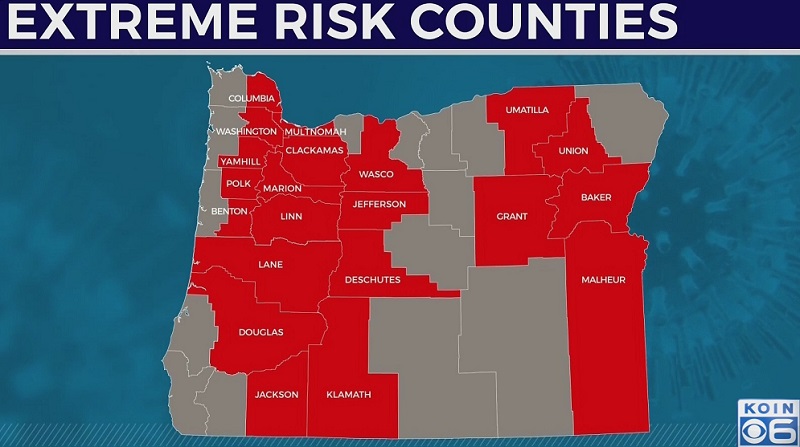PORTLAND, Ore. (KOIN) — Governor Kate Brown announced a new health and safety framework to combat the COVID-19 pandemic on Wednesday.
The plan will go into place when the entire state ‘freeze’ ends on December 3.
The state will start categorizing counties by risk level — Extreme Risk, High Risk, Moderate Risk, and Lower Risk — and different health and safety measures will apply.
Dr. Dean Sidelinger said many factors and data like test positivity rates and total case numbers go into deciding what risk level each county is in.
“We believe that by implementing this framework, it will enable us to better manage the impacts of COVID-19 through the winter,” Sidelinger said. The biggest change is that even in counties in extreme risk, restaurants will be allowed to operate outdoor dining at limited capacity.
OHA officials will examine county data on November 30 to determine which risk level each county is in. In each subsequent two-week period, the Oregon Health Authority will examine and publish county data weekly, but county risk levels will not change until the end of the second week. In the first week, counties will be given Warning Week data to prepare for potential risk level changes. In the second week, county risk levels will be updated based on that week’s data.
In counties with extreme risk, the following activities will be allowed, with health and safety protocols in place:
· Social and at-home gatherings with people from outside your household will be limited to a maximum of six people, with a recommended limit of two households.
· Restaurants, bars, and other eating and drinking establishments will be limited to a maximum of 50 people for outdoor dining only, with only six people per table. Take-out is strongly encouraged.
· Indoor recreation, fitness, and entertainment establishments, including gyms, will remain closed, however, outdoor recreation, fitness, and entertainment activities, including outdoor gym activities, will be allowed, with a maximum limit of 50 people outdoors.
· Retail stores, grocery stores, pharmacies, and indoor and outdoor shopping centers and malls will be limited to a maximum of 50% of capacity, with curbside pick-up encouraged.
· Faith institutions, funeral homes, mortuaries, and cemeteries will be limited to a maximum of 25% of capacity or 100 people indoors (whichever is smaller), or 150 people outdoors.
· Office workplaces will be required to utilize remote work to the maximum extent possible, with public-facing offices closed to the public.
· Personal services businesses will be allowed to continue to operate with health and safety measures in place.
· Long-term care facilities can allow limited outdoor visitation, following established health and safety protocols.
Clackamas County Public Health Director Philip Mason said the new safety guidelines are “really a call to action.”
“Your individual choices and behaviors and you plan to approach this holiday season really does have an impact on our essential healthcare workers,” he said. “We know COVID fatigue is very real, but it’s still here and we need to do everything we possibly can to prevent our hospitals from being overwhelmed.”
Mason urged people to continue to limit travel outside their homes and avoid social gatherings while continuing to wear face coverings and maintain physical distance.
For some small businesses, the new safety measures couldn’t come at a worse time. Charles Maes, the owner of Canby Asparagus Farms/Casa de Tamales, told KOIN 6 News daily sales are down by 50-80%.
“If it wasn’t for the fact that we’re providing walk-in and delivery, we would be dead,” Maes said.
During Wednesday’s press conference, OHA Director Patrick Allen said he expects Oregon to receive 30,000 doses of the vaccine. The first doses will go to front line healthcare workers and those living in congregant settings.
In a recent one-on-one interview with KOIN 6 News, the governor reaffirmed that she stands by her decision to temporarily halt social gatherings and some businesses despite pushback from critics. Brown said she enacted the partial lockdown in an effort to control the spread of COVID-19 before attempts to contain the virus are impossible.
“I don’t like doing this,” Brown said. “I feel because of the public health threats we are facing I have no choice.”
As of November 23, this is where each Oregon county stands:

Lower Risk:
Gilliam
Sherman
Tillamook
Wallowa
Wheeler
Moderate Risk:
Curry
Harney
Lincoln
Morrow
High Risk:
Clatsop
Coos
Crook
Lake
Hood River
Josephine
Extreme Risk:
Baker
Benton
Clackamas
Columbia
Deschutes
Douglas
Grant
Jackson
Jefferson
Klamath
Lane
Linn
Malheur
Marion
Multnomah
Polk
Umatilla
Union
Wasco
Washington
Yamhill